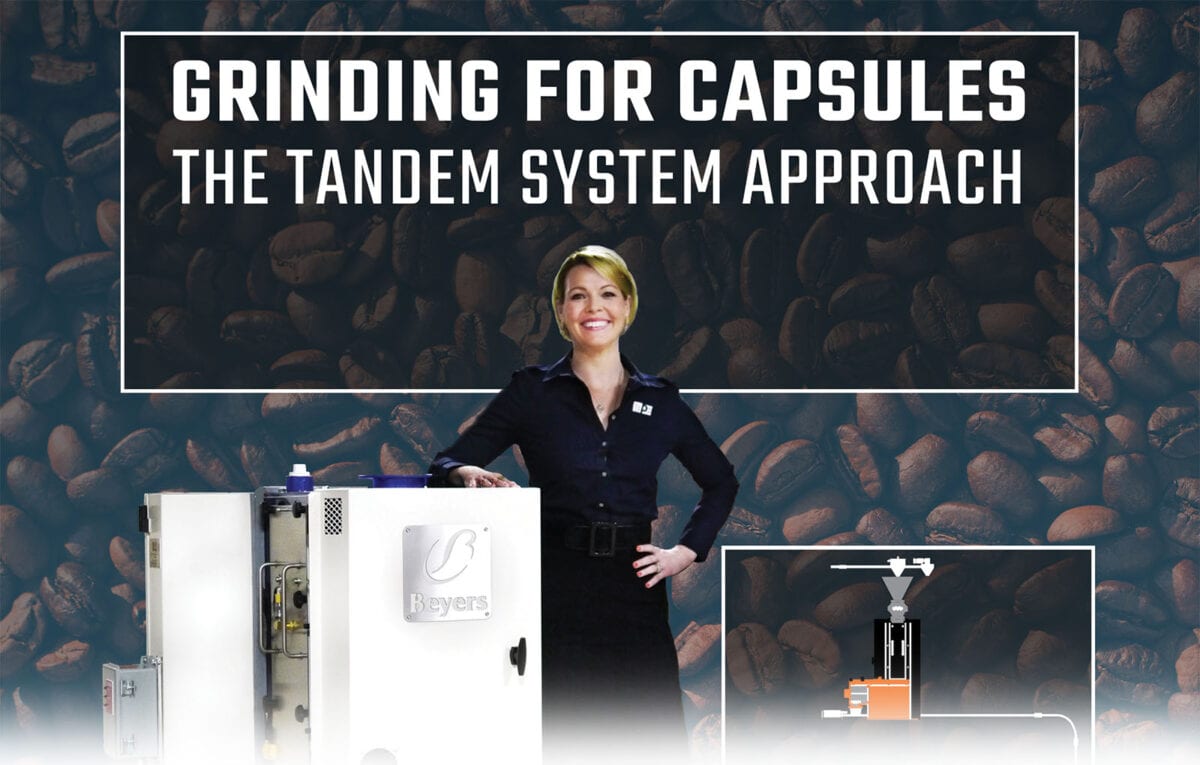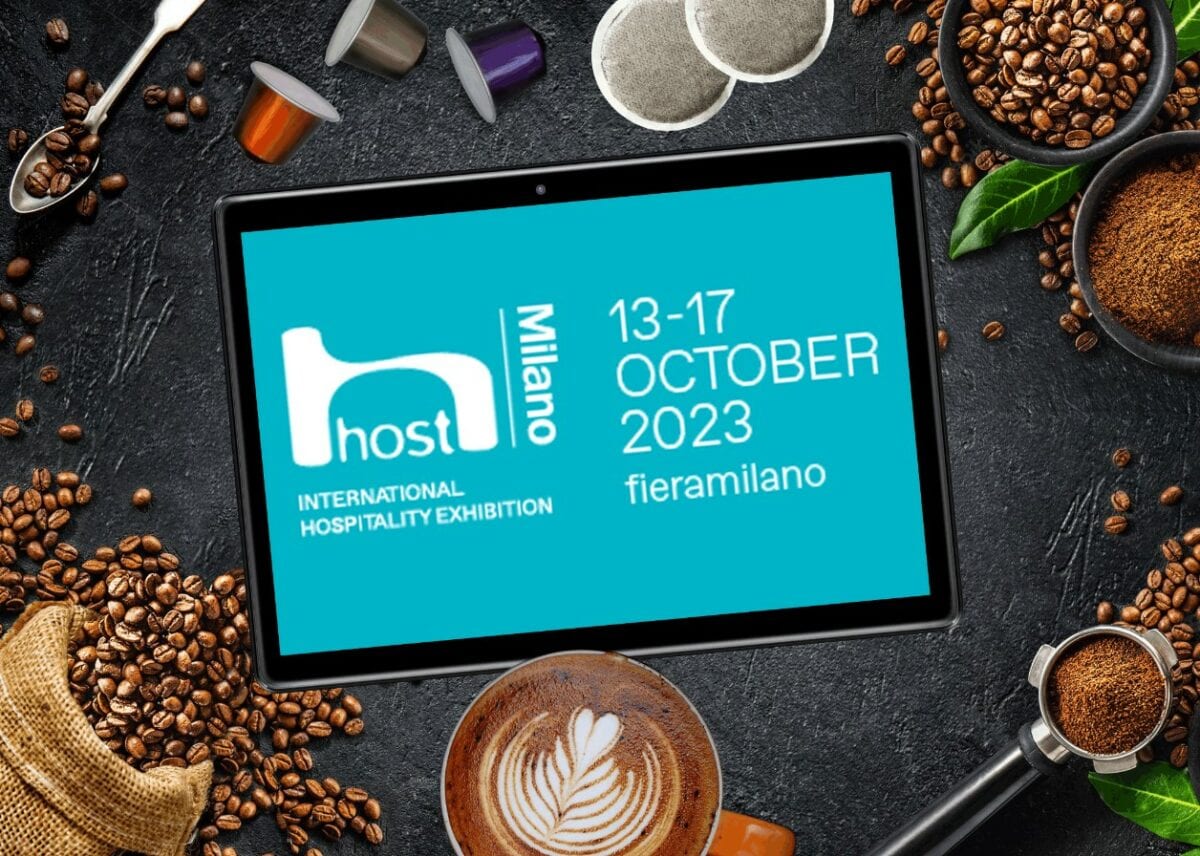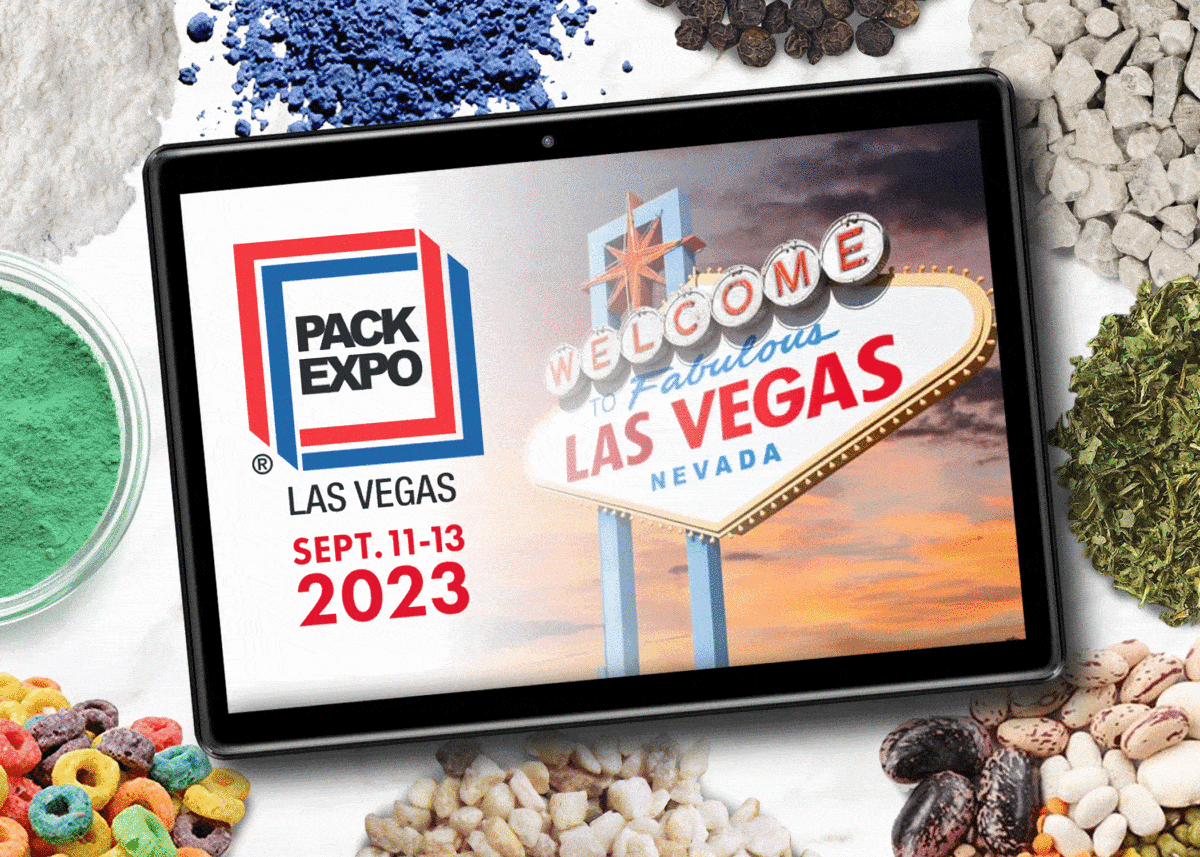Portion packs are the new normal for high-volume roasters.
Revenue from capsule coffee exceeded sales of traditionally packaged ground roast in the U.S. for the first time last year. In 2015 Americans will consume more than 1.8 billion cups of single-serve a month. European roasters will produce nearly as many espresso capsules and tea blenders will fill several billion single-serve tea capsules.
On both continents portion packs are quickly replacing ground and instant coffee and eroding sales of specialty tea in pyramid bags.
“Grinding is a crucial step in coffee processing and, when done properly, can dramatically improve coffee extraction and aroma retention, thereby optimizing the brewed coffee quality,”
— Scott Will
The New Normal
Roasting, grinding, packaging and marketing coffee in portion packs is the new normal for coffee manufacturers supplying millions of in-home and office brewers. Market penetration remains thin in food service but deals like Subway’s purchase of Keurig’s Bolt brewers for its 20,000 U.S. outlets suggest that is changing as well.
Sourcing, roasting and blending are little changed but single-serve demands great flexibility in packaging and significantly greater precision and new techniques for grinding, filling and packing capsules.
The first hurdle for roasters was to replicate with consistency the flavor profile of the most popular blends from big brands like Folgers and Starbucks. It took five years for the team at Peet’s Coffee & Tea to develop techniques (primarily grinding and compacting) that guaranteed consumers could not tell the difference between ground roast and portion pack versions of their most popular blends.
Accustomed to a golden standard based on 4 oz. of coffee, 64 oz. of water and a four minute extraction, roasters had only 20 seconds and 8 grams of coffee to achieve the ideal brew strength of 1.15% to 1.35% solids. This required the extraction of be- tween 18% and 22% of the coffee particle’s soluble solids.
Contract roasters can now replicate extraction profiles in a month.
Brewers dispensing 8 oz. of hot water in less than 30 seconds mean that “we are already behind what is required for the optimum brew cycle,” observes Jeff McIntosh, roast master at Intelligent Blends, San Diego.
“We spend hours of R&D working with our customers’ blends to ensure the same great taste when moving from drip grinds to single serve formats,” he said. “To do this we repeatedly test dissolvable solids and adjust the extraction percentage of the final cupped products,” he said.
It Boils Down to Extraction
Capsule design, fluid dynamics, the permeability of internal filters, brewers that generate sufficiently high water temperature are important considerations but grinding is critical to full flavor and consistency.
Albert Bezjian with Ditting USA observes that “regardless of brewing method it is important to select the best green coffee beans and roast them to perfection, but when it comes to capsules the CRITICAL ELEMENT
is grinding the roasted beans into uniform particle sizes for consistency in brewing.”
To extract full flavor this quickly requires a precise grind. Too coarse and the capsule will produce a weak, tea-like brew. Too fine and you get bitter over- extraction with an unpleasant peanut, grassy taste.
“Coffee grinding is a crucial step in coffee processing and, when done properly, can dramatically improve coffee extraction and aroma retention, thereby optimizing the brewed coffee quality,” according to Scott Will, director of sales at Modern Process Equipment (MPE).
Bezjian, whose title at Ditting is problem solver, explained that “as coffee drinkers learned how to make better coffee, they switched to filter methods and kept drinking stronger (bolder) co fee, and needed finer grounds for better extraction.”
To make Turkish coffee, for example, every bean is evenly divided into 30,000 particles. A machine operating at 1,000 kilos per hour produces 145 billion nearly identical grains.
The 200 micron (μm) grind used for espresso capsules is about double that of Turkish coffee which is ground to a consistency that resembles our. The ideal diameter for K-Cups doubles again, to approximately 850 μm.
“If you don’t have consistent particle sizes, every cup will taste different and the customer will not be satisfied. Consistency is why K-Cup and pour over single cup brewing have taken off so rapidly,” said Bezjian. “At MPE, we customize our grinders for each customer to optimize the internals and deliver the best grind size and density for each coffee capsule application, and we offer different designs for various K-Cup capsules and European-style capsules in the marketplace,” said MPE’s Will.
“Faster brew times translate to optimized grind sizes with minimal margin for grind errors,” he said. “The flavor of your coffee depends on the coffee grind size and pro le, which is controlled by the grinder, as well as the amount of coffee used, which is related to the densifier. By altering the grinder variables, you can change the taste and intensity of the coffee,” according to Will.
It is important not to make the grains impermeable, explains Karl Schmidt, president of Probat Burns in Chicago. Visualized on a Gauss curve, a small percentage of the grounds should be slightly larger and above the curve to facilitate flow and a small percentage should be finer to enhance extraction, he explains. This is critical with espresso machine capsules with brewers that exert 10+ bars of pressure.
“You want to control “overs” and “fines” but not eliminate them,” ex- plains Schmidt, citing a text on coffee quality by Andrea Illy. Due to the high pressure necessary to extract espresso you need a certain amount of larger particles to allow the water through.
“The trick is to crush the coffee cells and then get the water in and out,” said Schmidt.
Grinders
There are two phases to grinding, a crushing phase where the convolute structure of the brittle beans are broken into fragments, typically about one millimeter in size; and a second phase, properly called grinding in which the fragments are sheared.
Dry-process grinders are either “impact” de- signs that shatter coffee into irregular particles or the much preferred “gap” design in which coffee is dropped through a shear gap between the notched surfaces of cutting tools (conical grinders, cutting rollers or at grinders).
“You have to be perfect in your execution in grinding. You’re dealing with exact brewing times and very small amounts of coffee in a fixed volume at high density. Everything has to line up perfectly,” explains MPE’s Will.
Grinders must contend with many sources of disturbances which cause the equipment to per- form irregularly. Coffee beans not only come from different botanical varieties and producing countries, they vary by season and climate. Blends of- ten include beans processed by diverse methods. Beans that are fresh contain more moisture than beans stored for many months in a warehouse.
Neuhaus Neotec sales and project manager Ralf Torenz said that Neuhaus recently introduced roll grinders with a capacity of 150 to 1,000 kilos per hour specifically designed for capsule and pod coffee.
Flexibility is a key attribute in dealing with what amounts to daily disturbances, he explains.
“The motor and each roller motor have their own frequency converters. As a result, each roller can be driven at its own speed. The grinding pressure can also be individually adjusted to new product specifications when changing between types of coffee. These parameters can be saved as a recipe for quick adjustment when changing between coffees,” he said.
During a presentation at COTECA 2014 in Hamburg, Germany, Torenz described the challenges roasters face due to high capacity production. The most fundamental is defeating heat build-up (which imparts a ‘burnt’, bitter taste from overheating) and protecting against the loss of aroma while delivering precise particle size. Grinding large volumes at high speed necessitates innovations in design beyond that required for simple ground roast.
Keep It Cool
Dissipating heat is critical with finer grinds. Grinding surfaces become red hot from friction and the heat generated by fracturing during long production runs unless aggressively cooled. As metal surfaces expand it is “absolutely necessary” for the roller gap to remain constant which requires accurate gap adjustment.
Schmidt at Probat Burns said the UW series grinders at 300 μm can output 2,000 to 3,000 pounds per hour. Grinding to precise size is not a challenge for any grinders on the market, he said. Consistency over a long, high-temperature run is what sets roller grinders apart.
“The hotter it gets the worse it gets,” said Schmidt. In his view the engineer- ing challenge is developing grinders that control thermal expansion and respond to coffee’s many variables while “maintaining consistency in the gap.”
Compacting and Filling
During roasting the beans swell and when air-cooled a high quantity of gas is trapped in the cells. Water quenching causes more gas to escape due to greater cell wall cracking but the beans retain residual moisture.
Consider volume: capacity remains the same at 5-6 grams for Nespresso capsules and 8-14 grams for K-Cups but densely packing the coffee will increase the strength of the brew.
The density of the coffee is really important to get a consistent dose, according to Robert Melikian, c.e.o. of Automatic Brewers and Coffee Devices, Inc., (ABCD) in West Conshohocken, Penn.
“When you are packing single-serve you are packing volumetrically, not with a scale. If the coffee is fluffy or overly dense it will change the weight in the capsule,” he said.
Using a normalizer/densifier to mix the grind is essential, said Melikian.
You can only compact coffee to a certain degree, perhaps 10% to 15%, Pro- bat’s Schmidt. explains.
“Densifying” originally referred to compressing the coffee to fill a one pound can. It is necessary because in addition to the roasted beans, a certain amount of chaff ends up displacing some of the ground coffee in the capsule. Chaff is of no benefit but removing all the silverskin is not practical.
There is some work being done on producing high yield coffee, in which the chaff is eliminated. These grinders crush individual cells to a very precise particle size. The Marco Uber Grinder, for example, features burrs held in place by magnets to eliminate screw holes, glass pearl blasting, titanium plating and a pour- over pro le optimized for 750 to 800 μm granules but these specialized low volume grinders are impractical for commercial fill and pack.
Capsule Design
All capsules must meet two critical requirements – insure a long product shelf life and withstand the heat and pressure of brewing. Keurig’s K-Cups are larger, thinner and contain more coffee than Nespresso’s capsules which hold 5 grams of coffee and withstand pressures up to 19 bar (VertuoLine).
Nespresso capsules are made of aluminum lined with a protective coating. A grid at the base of the capsule is punctured to allow the coffee to exit. Nestle’s Dolce Gusto 54mm capsules are thermoformed polypropylene with an EVOH barrier and a hole in the base. The latest K-Cup design has a spout. To save money Nespresso knockoffs are made of injection-formed plastic. K-Cup compatible capsules often feature an open-sided mesh design in which the capsule acts as filter.
Regardless of design, capsules must prevent exposure to light, moisture and oxygen, which impair aroma and taste. They must also accommodate internal challenges that include settling, clumping and the release of carbon dioxide (C02). A kilo of roasted coffee releases six liters and espresso blends up to 10 liters of CO2 within five weeks, an amount sufficient to damage packaging. In his book Espresso Coffee: The Science of Quality Andrea Illy estimates that the release of CO2 is directly correlated to the loss of volatiles. Release 50% of the CO2 and half the aromatics wisp away. The darker the roast the greater loss, he writes.
“Coffee capsules are so small in size that the majority of individuals do not pay much attention to their complexity,” said Kai Wulff, general sales manager food & beverage with Glatfelter’s composite fibers business unit.
When Keurig’s patent protection expired in 2012 three solutions emerged. California-based Rogers Family Coffee introduced the OneCup, a plastic ring with coffee suspended in a soft mesh filter.
TreeHouse Foods introduced a hard sided Keurig compatible capsule popular with large grocery chains with private label offerings. Hard sided capsules often contain a filter that must possess excellent literation properties, runnability and pressure resistance without imparting any flavor, said Wulff.
LBP introduced an open-sided generic capsule compatible with Keurig brewers called the UpShot. LBP cup utilized the mesh sides of the capsule to filter the coffee. Buying empty capsules from LBP avoided the 6.2-cents per cup royalty that licensed users paid Keurig.
Melikian at ABCD uses LBP manufactured mesh sided cups. To reduce exposure to oxygen and increase shelf life, open sided capsules must be Nitrogen flushed and overwrapped or pack- aged in conventional coffee bags with valves.
Since there is no internal filter the cups hold up to 14 grams of coffee. One of the big benefits is the “ahhh” effect, said Melikian. “When a cus- tomer opens the pouch they instantly smell the coffee,” he said. “You can see the coffee through the clear lid,” he added.
Mother Parkers Tea & Coffee in Toronto de- signed its RealCup to be compatible with Keurig machines but with an internal plastic filter. Oxygen is purged by nitrogen gas eliminating the need for overwrap. Last year a biodegradable version called the EcoCup was introduced and later awarded the “Most Innovative Product” by the Packaging Consortium.
“The EcoCup solution is a true game-changer in the rapidly growing single-serve capsule market,” said Mother Parkers Bill VandenBygaart.
Packing Cartons
The capsule filling line at POD Pack International’s new $10.1 million manufacturing facility in Ba- ton Rouge is state-of-the art. Tom Martin, e.v.p. and c.o.o. of the coffee co-packer said that weight tolerances for the single-serve filling and sealing line were set at two-tenths of a gram.
“At 25,000 cups per shift we rejected only 50,” said Martin. “I’ve never seen anything like that. It’s better than we expected,” he said. The combination grinder, degasser and densifier (supplied by MPE) ills the formed polystyrene capsules in a controlled atmosphere using a nitrogen flushing technique that displaces air in the space below the built-in paper filter. The Keurig compatible capsules are then sealed and “nested” in 12-, 18- and 24-count cartons.
Martin installed the line in December. “It was the nearest thing to plug-and-play I’ve ever seen,” he said.
Fill and Packing Equipment
Early adopters spent millions per fill line on high volume packaging machines. To meet roaster requirements companies like OPEM, an early manufacturer of capsule filling equipment, developed machines with eight fill lines and outputs up to 1,400 capsules per minute. Optima’s CFL-4 fills 20 capsules at a time to produce 1,500 per minute. IMA Industries pairs its 480 per minute filling and sealing machines with an oxygen extraction unit and nitrogen gas flushing, using hermetic chambers the size of a processed capsule, to as- sure minimum gas consumption. Seals can be set by heat or ultrasound.
Production runs initially were massive to justify the machine expense. Waste costs were high due to the capsule expense. It took much trial and error to reduce oxidation of the ne grinds while permitting the release of carbon dioxide during packing. In the U.S. Keurig Green Mountain pioneered the initial design, establishing over a period of 20 years an industry standard for capsule diameter and depth.
Production increased from hundreds of millions, to billions of capsules per factory as Keurig inked contracts with Starbucks, Folgers and Dunkin’s Brands. Eventually even Kraft Foods, which owns the competing Tassimo system, decided to offer its Maxwell House, Gevalia, Yuban, and McCafe coffee in licensed K-Cups. Keurig now licenses 400 beverage types owned by 60 brands including the top three selling coffees in America.
Intelligent Blends was among the first co-packers to accept minimum runs of 25,000. Melikian offers a program that lets small brands pack as little as 50 pounds of coffee (at 38 cups to the pound about 2000 filters). His company now produces 50,000 cups a day in two 7.5 hour shifts and the backlog is growing, he said. No wonder, some of his boutique roasting clients are getting $2 a cup retail.
Martin, who just opened a new production line at POD Pack, is already making expansion plans.
Capsule solutions demand greater cooperation between equipment manufacturers, roasters and co-packers, according to MPE’s Will.
To meet the needs of a prominent North American client initially “we created an engineered, bimodal grind pro le to match their brewer requirements, and deliver a better coffee taste profile,” said Will.
Their previous grind process resulted in an unusually long brew time and a “roast forward” taste pro le. This taste pro le is where an abundance of flavor hits the tongue early in the sip, but has a flat finish, which is not desirable. We were able to alter their grind pro le to minimize the internal “dust” in the coffee. The flavor pro le changed to a cleaner, more consistent cup of coffee, with a longer lasting flavor finish, which was ultimately more desirable,” said Will.
That’s the bottom line. Taste.
All the technological advances, precise adjustments, design engineering and wizardry are invisible to consumers who want full flavor and variety with push button convenience. It’s a lot of work for a 30-second pour. It’s a good thing they are willing to pay the price.



